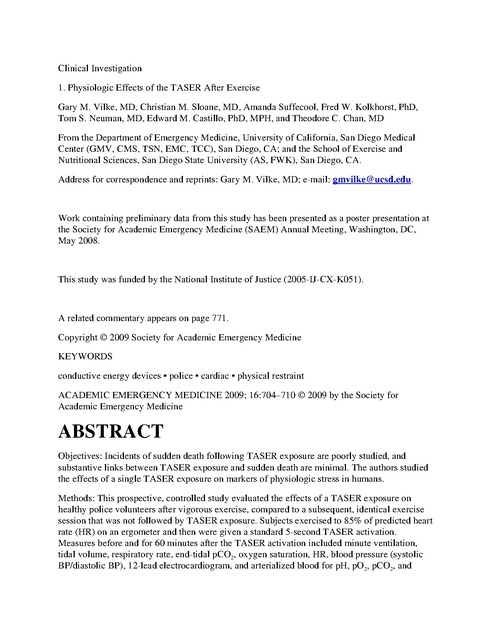Vilke Et Al Physiologic Effects of the Taser After Exercise Abstract 2009
Download original document:

Document text

Document text
This text is machine-read, and may contain errors. Check the original document to verify accuracy.
Clinical Investigation 1. Physiologic Effects of the TASER After Exercise Gary M. Vilke, MD, Christian M. Sloane, MD, Amanda Suffecool, Fred W. Kolkhorst, PhD, Tom S. Neuman, MD, Edward M. Castillo, PhD, MPH, and Theodore C. Chan, MD From the Department of Emergency Medicine, University of California, San Diego Medical Center (GMV, CMS, TSN, EMC, TCC), San Diego, CA; and the School of Exercise and Nutritional Sciences, San Diego State University (AS, FWK), San Diego, CA. Address for correspondence and reprints: Gary M. Vilke, MD; e-mail: gmvilke@ucsd.edu. Work containing preliminary data from this study has been presented as a poster presentation at the Society for Academic Emergency Medicine (SAEM) Annual Meeting, Washington, DC, May 2008. This study was funded by the National Institute of Justice (2005-IJ-CX-K051). A related commentary appears on page 771. Copyright © 2009 Society for Academic Emergency Medicine KEYWORDS conductive energy devices • police • cardiac • physical restraint ACADEMIC EMERGENCY MEDICINE 2009; 16:704–710 © 2009 by the Society for Academic Emergency Medicine ABSTRACT Objectives: Incidents of sudden death following TASER exposure are poorly studied, and substantive links between TASER exposure and sudden death are minimal. The authors studied the effects of a single TASER exposure on markers of physiologic stress in humans. Methods: This prospective, controlled study evaluated the effects of a TASER exposure on healthy police volunteers after vigorous exercise, compared to a subsequent, identical exercise session that was not followed by TASER exposure. Subjects exercised to 85% of predicted heart rate (HR) on an ergometer and then were given a standard 5-second TASER activation. Measures before and for 60 minutes after the TASER activation included minute ventilation, tidal volume, respiratory rate, end-tidal pCO2, oxygen saturation, HR, blood pressure (systolic BP/diastolic BP), 12-lead electrocardiogram, and arterialized blood for pH, pO2, pCO2, and lactate. Each subject repeated the exercise and data collection session on a subsequent data, without TASER activation. Data were analyzed using paired Student's t-tests with differences and 95% confidence intervals (CIs). Statistical significance was adjusted for multiple comparisons. Results: A total of 25 officers (21 men and 4 women) completed both portions of the study. After adjusting for multiple comparisons, the TASER group was significantly higher for systolic BP at baseline (difference of 14.1, 95% CI = 8.7 to 19.5, p < 0.001) and HR at 5, 30, and 60 minutes with the largest difference at 30 minutes (difference of 7.0, 95% CI = 2.5 to 11.5, p = 0.004). There were no other significant differences between the two groups in any other measure at any time. Conclusions: A 5-second exposure of a TASER following vigorous exercise to healthy law enforcement personnel does not result in clinically significant changes in ventilatory or blood parameters of physiologic stress. Received January 23, 2009; revision received March 27, 2009; accepted April 12, 2009.





